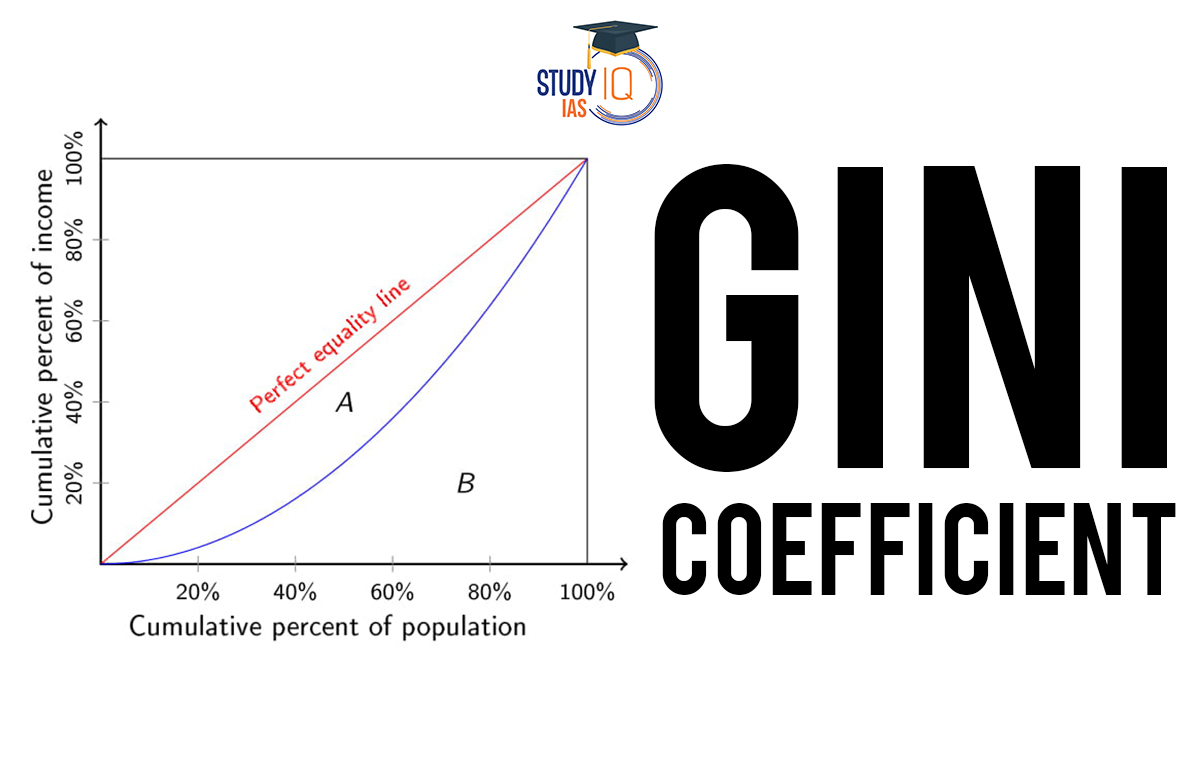Table of Contents
Gini Coefficient
In simple terms, the Gini coefficient is a way to measure how evenly or unevenly income or wealth is distributed in a society. A lower Gini coefficient indicates a more equal distribution, while a higher Gini coefficient suggests a greater concentration of income or wealth in a small percentage of the population.
Read about: Index Ranking of India 2022
Gini Coefficient Formula
The formula for calculating the Gini Coefficient is:
G = (A / (A + B))
Where:
G = Gini coefficient
A = area between the line of perfect equality and the Lorenz curve
B = total area under the line of perfect equality
The Lorenz Curve is a graph that shows the cumulative percentage of income or wealth on the vertical axis and the cumulative percentage of the population on the horizontal axis. The line of perfect equality is a straight diagonal line that represents perfect income or wealth equality.
To calculate A, you first divide the population into equal-sized groups, such as quintiles or deciles, and calculate the cumulative percentage of income or wealth held by each group. You then plot these percentages on the vertical axis of the Lorenz curve and connect the points to form a curve. A is then calculated as the area between this curve and the line of perfect equality.
To calculate B, you simply divide the total area under the line of perfect equality by 2. The resulting Gini coefficient ranges from 0 to 1, with 0 indicating perfect equality and 1 indicating perfect inequality.
Read about: GDP of Indian States
How to Calculate Gini Coefficient?
To calculate the Gini coefficient, you need to follow these steps:
- Step 1: Arrange the population by their income or wealth, from the poorest to the richest.
- Step 2: Calculate the cumulative percentage of the total income or wealth held by each percentile of the population. For example, the cumulative percentage of the total income or wealth held by the bottom 10%, 20%, 30%, and so on, up to 100%.
- Step 3: Plot the cumulative percentages on a graph, with the cumulative percentage of the population on the x-axis and the cumulative percentage of income or wealth on the y-axis. This graph is known as the Lorenz curve.
- Step 4: Calculate the area between the Lorenz curve and the line of perfect equality, which represents a society with perfect income or wealth equality. This area is denoted as “A”.
- Step 5: Calculate the total area under the line of perfect equality. This area is denoted as “B”.
- Step 6: Divide “A” by “B”, and then multiply the result by 100. This gives you the Gini coefficient as a percentage.
The resulting Gini coefficient will be a number between 0 and 100, with 0 indicating perfect income or wealth equality, and 100 indicating perfect income or wealth inequality.
Read about: GDP Deflator
Gini Coefficient and Lorenz Curve
The Lorenz curve and the Gini coefficient are two related measures of income or wealth inequality.
The Lorenz curve is a graphical representation of the distribution of income or wealth in a society. It plots the cumulative percentage of the total income or wealth held by the bottom x% of the population, against the cumulative percentage of the population from the bottom. The Lorenz curve is a curved line that typically lies below the line of perfect equality, which represents a society in which everyone has an equal share of income or wealth.
The Gini coefficient is a numerical measure of inequality that can be calculated from the Lorenz curve. It is calculated as the ratio of the area between the Lorenz curve and the line of perfect equality, to the total area under the line of perfect equality. The resulting number ranges from 0 to 1, with 0 indicating perfect equality and 1 indicating perfect inequality.
In other words, the Lorenz curve shows the actual distribution of income or wealth in a society, while the Gini coefficient summarizes that distribution into a single number. The Gini coefficient can be useful for comparing the level of inequality between different societies or over time, but it does not provide as detailed information as the Lorenz curve.
Read about: Basel Norms
Gini Coefficient UPSC
The Gini coefficient is an important topic for UPSC aspirants as it is part of the UPSC Syllabus for various exams such as the Civil Services Preliminary and Mains Examination.
Aspirants preparing for the UPSC exams should be familiar with the concept of the Gini coefficient as it is a commonly used measure of income or wealth inequality in society. Understanding the Gini coefficient can help aspirants analyze the economic and social conditions of a country, and how policies can impact inequality in a society.
Therefore, it is essential for UPSC aspirants to have a good understanding of the Gini coefficient, and to practice answering related questions in UPSC Mock Test and UPSC Online Coaching programs. This will help aspirants improve their overall understanding of the topic and increase their chances of scoring well in the UPSC exams.
Read More: Types of Inflation


 Goods and Services Tax (GST), Objectives...
Goods and Services Tax (GST), Objectives...
 World Oceans Day 2025, History, Theme, S...
World Oceans Day 2025, History, Theme, S...
 World Environment Day 2025, Theme, Histo...
World Environment Day 2025, Theme, Histo...





















